CAPUCHIN FRIARS, MORGON, FRANCE
St. Francis of Assisi (1181-1226) founded the Order of the Friars Minor (literally, the Little Brothers). After his death (and ever since), there have been many reforms separating the Order into different groups. In 1897, Pope Leo XIII regrouped the Friars Minor into three branches: (1) the Order of Friars Minor of the Leonine Union, (2) the Order of Friars Minor conventual, and (3) the Order of Friars Minor Capuchin.
The Conventuals and the Capuchins had already been in existence, but the Friars Minor of the Leonine Union were brought together from smaller groups; they are also called quite simply "The Order of Friars Minor," "Observants" or "Franciscans." All three Orders are truly Franciscan; they all follow the Rule of St. Francis. They differ only in their constitutions with slight differences in their habits; for instance, the Capuchins are bearded while the others must be clean-shaven.
The Capuchins are the strictest observants of the Franciscan Rule, while the Conventuals are the most relaxed. The Observants, or the Franciscans, are in between, but perhaps closer to the Capuchins. The Capuchins are hermit preachers with a mixed vocation, leading at the same time a contemplative and apostolic life. The Capuchins were started in 1525 in Italy by Blessed Matthew of Basci in an attempt to return to the pure spirit of St. Francis. Even the Capuchin habit is closer to the original. The name comes from the Italian cappuccino ("little hood"): the children made fun of the new friars' hoods, which were not little but big in comparison with the other Franciscans'. (Cappuccino coffee, coincidentally, gets its name from its color, which is supposed to be like the Capuchin habit also.)
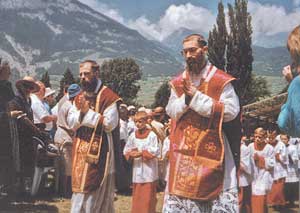
The Spirit of St. Francis
St. Francis's ideal was to follow and imitate Christ, poor and crucified: poor in His birth in the stable, poor in His ignominious death on the Cross, poor in the Blessed Sacrament under the humble appearance of bread and wine.
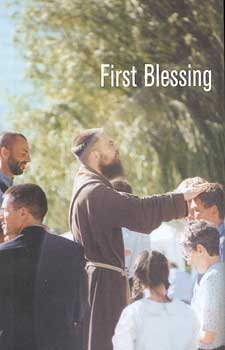 |
|
The first Capuchins wanted to live as close as possible to this ideal by a life of prayer and penance in poverty, chastity and obedience, according to a strict interpretation of St. Francis's Rule. The Capuchin Constitutions have remained the same since 1525, undergoing only very minor modifications such as in 1909 when the General Chapter set the Constitutions in order, tying up loose ends and correcting abuses which had crept in. These revised Constitutions (revised, not new) were approved by Pope St. Pius X. In 1925; they were adapted to the revised Code of Canon Law. These adaptations and revisions, however were nothing like the sweeping changes made in 1968.
The Second Vatican Council called upon the religious Orders to revise their constitutions "conveniently" each according to the "original spirit of the institute." In no way did the Council ask for a new constitution. However, what happened in 1968 was nothing short of a revolution. The Capuchins changed their constitutions completely, changing their whole way of life and even their conception of themselves. Many tried to resist but were obliged to leave and found new groups, but they were no longer Capuchins.
Capuchin Saints
For almost five centuries, this Franciscan reform has furnished the Church with a beautiful phalanx of saints. Forty-seven Capuchins have been raised to the honor of the altars. Some better known Capuchin saints are: St. Felix Cantalice (+1587); St. Lawrence of Brindisi (+1619); St. Fidel of Sigmaringen (+1622); St. Crispin of Viterbo (+1750); Bl. Diego-Jose of Cadiz (+1801); St. Conrad of Parzham (+1894); St. Leopold Mandic of Castelnuovo (+1942). The most famous Capuchin saint is certainly Padre Pio (+1968), the stigmatized Italian priest. It is said that he was afflicted by all the changes in the Order and in the Church, and that he asked God to take him out of this valley of tears, which is the world.
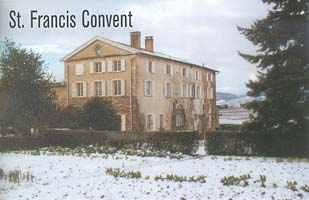 |
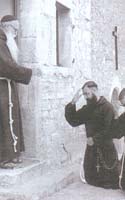 |
The Community at Morgon
The community at Morgon was founded by the late Father Eugene de Villeurbanne (1904-90) who was a very active member of the Order before the Second Vatican Council. A Capuchin from the Province of Lyons, he was a great preacher of missions and retreats, and a former missionary in Central Africa. He wanted to always remain faithful to the habit that he received at his clothing, to the Rule that he vowed at his profession, and to the Mass that he celebrated at his ordination. After the Council, he received permission from his superiors to live outside the community as a hermit. When young men started coming to him who had no desire to join the modern Capuchins, but wanted to become real Capuchins like him, Father Eugene saw it as a sign of God that he should begin a novitiate to keep alive the true Capuchin and Franciscan spirit. This was how their community started.
The Friary today is located at Morgon in Beaujolais, a little over 30 miles north of Lyons, in the Rhone (France). A new novitiate (see interview) will be opened at the end of 2005 at Castelnau d'Arbieu, in the Gers.
 |
 |
Their Way of Life
Their way of life is mainly contemplative, but their priests also go out into the world to preach missions and retreats in addition to hearing confessions. A large part of the day is taken up with the recitation in common of the Divine Office. They retire for sleep at 8:30pm, then rise at 1:00am for Matins and Lauds and return to bed after Matins and Lauds, which lasts between a half-hour to an hour. They next get up at 4:25am for mental prayer (a meditation on the Passion), which makes for a total of seven hours of sleep, even though it is interrupted. Not all the friars do this; those studying for the priesthood, the lay brothers for the time of their novitiate and the three years of simple vows, as well as the priests who have a heavy charge like teaching or getting ready to preach a mission or retreat, are not obliged to follow this program in its full rigor. The friars who do generally have a siesta in the early afternoon.
They have two hours a day of mental prayer, one in the morning and another in the evening. Beyond this, there is the rest of the Office (Prime being recited at 6:20am) and the Mass at 6:40am. During their thanksgiving after Mass (which lasts about twenty minutes), another Mass is celebrated. They leave the choir after the Pater. There is also the Rosary, Stations of the Cross, private devotions and spiritual reading. Every morning, for half an hour at 5:45am, they read the Bible.
The Capuchins have three "Lents" or period of fasting between All Saints' Day and Easter. The first is from All Saints' Day to Christmas. The second is from Epiphany (or, rather, the day after, the seventh of January) for forty days (there is no fasting on Sundays). This Lent is called die Benedetto, (the Blessed Lent) because St. Francis promised great blessings if it was kept. Then, of course, aere is also the Great Lent of the Church. In addition, the Capuchins fast every Friday.
The fast consists of a very light breakfast (at 7:40) and supper, but the midday meal is a full meal. During the rest of the year (and every Sunday), they have three meals a day. The friars who find it too hard to fast for six days of the week do it every second day. They abstain from meat every Wednesday, Friday and Saturday; but they eat meat at the midday meal on other days. They have wine with every meal, with the exception of breakfast when strong coffee takes its place.
After breakfast, everybody retires into his cell, or a common room heated in winter, for an hour of reading or studies. The rest of the morning, until 11:35am (when Sext and None are recited) is occupied by intellectual work by the clerical brothers in preparation for apostolic work, and manual work for the lay brothers.
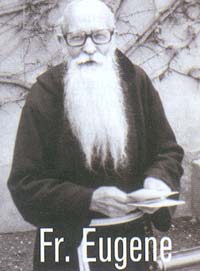 |
The midday meal is preceded by the Chapter of Faults (where the community members publicly confess the faults against the rule of the house). At the end of the meal, all clear the table and after grace, while reciting the Miserere, they visit the Blessed Sacrament, followed by prayers for their benefactors. This finishes while the priest who is hebdomadarian (i.e., the priest who leads the liturgical functions and says the Conventual Mass for the week) washes the dishes helped by the acolytes. The others go for a walk in a common recreation in the vicinity of the convent.
Someone rings the bell for the end of the recreation at 1:30pm for the Great Silence, which may be one of a siesta, (at any rate a free time) until Vespers at 2:00pm followed by the Rosary.
After this, everyone takes up their work again, unless it is Thursday, when they go for a long walk. At 5:00pm, spiritual reading or devotions are done. Compline is recited at 5:30pm and is followed by the evening mental prayer, of which the ringing of the bell for supper (at 6:45pm) marks the end.
A recreation follows the meal until the "Great Pardon" at 7:45pm. Usually, everyone is asleep by 8:30pm.
Grand Silence is always kept from 8:00pm in the evening until after the office of Terce (9:00am) the following morning. Silence is also kept in the early afternoon for an hour or so. During the day, if they have to speak, the novices and those who have made simple vows talk to each other kneeling, so as to prohibit "chatting" and to make them say only what needs to be said. After the midday and evening meal, there is a community recreation. The community spirit is a very important aspect of the Franciscan life.
How Does One Become a Friar?
First of all, one enters as a postulant: the postulant wears lay clothes but lives in the community. The period of postulancy is one to six months for a cleric (a candidate for the priesthood) and six months for a lay-friar (who, however, does wear the habit).
The second step is the novitiate, which lasts from a year to a year and a half. At this point, the habit, with the hood, is worn. The novice does manual labor and studies Franciscan spirituality and the religious life. The novitiate allows the Capuchins to judge if the subject is capable of combining the observances of the Capuchin life with the studies necessary, and to progress in the virtues necessary for the religious and priestly life.
The third step is the profession of simple vows of poverty, chastity and obedience, which are binding for three years. The lay brothers continue studying Franciscan spirituality, the religious life and the catechism, while the clerics study philosophy following St. Thomas Aquinas.
The fourth step is the profession of solemn vows, which are binding for life. It is at this stage that the cleric starts theology. Usually, perpetual profession and the first of the major orders takes place during the second year of theology, and the priesthood received at the end of the third year. During the year following the ordination to the priesthood, the young priests preach at the convent but do not hear confessions, continuing their formation in a final year of studies before taking up progressively the different occupations of the holy ministry.
What is the difference between the priests and the lay brothers?
Weekday Schedule12:55 AM First rising, Matins (up to 1 hour) 4:25 AM Second rising 4:45 AM Lauds and meditation 5:45 AM Scripture reading 6:25 AM The Angelus, Prime and the Conventual Mass (of the community) 7:20 AM Thanksgiving after Mass, followed by breakfast 8:00 AM Study 9:00 AM Terce, followed by the end of "Great Silence" 9:15 AM Classes, study or work 11:40 AM Sext and None NOON The Angelus, Lunch, prayers in choir, dishes, and recreation 1:30 PM Grand Silence, followed by Rest (siesta, or small quiet jobs) 2:00 PM Vespers followed by Rosary 2:40 PM Work or study (on Thursday, a walk; on Friday, choir and liturgy practice; on Saturday, cleaning the convent) 5:00 PM Personal devotions (on Friday, and certain feastdays, Low Mass) 5:30 PM Compline, prayers, and meditation (on Friday, Stations of the Cross) 6:45 PM Dinner, dishes, recreation 7:45 PM The Angelus, the "Great Pardon," Lights out (Grand Silence) |
The lay brothers (lay friars) have a more contemplative life than the priests because their life is more hidden and withdrawn. Confided to them is certain manual labor (the garden, kitchen, repairs, laundry, shoemaking, sewing, etc.] or the responsibilities within the interior of the convent (sickroom, porter, secretary, sacristy). On some occasions they even show themselves as builders.
These jobs of an obscure aspect are in actual fact the atmosphere of Nazareth, so favorable to the spirit of humility and sacrifice. The lay brothers participate at the same community exercises as the clerical brothers, have the same prayer time in the choir, and have the same voice at the chapter.
Like St. Francis, they are considered as the priests' best helpers in the apostolate, their "hidden, latent forces," who by their life completely hidden in God obtain the grace which can save souls. They thus make it a duty and an honor to support the priests by the unsuspected merit of their life of abnegation, prayer, work and humility.
The priests are, of course, involved with their ministry and are often away from the friary. However, "often" does not mean "always": it is the priests who instruct the novices and young religious in catechism, who give spiritual conferences and who preach the monthly retreat to the community. They also look after the library and teach philosophy and theology to the clerical brothers.
The ministry of the Capuchin priests is exercised mainly in the confessional and from the pulpit. Their specialty in the past was the preaching of parish missions, spiritual exercises of two to three weeks during which two or three priests evangelized a parish. At the present time, they often regret having to turn down invitations to preach sermons, conferences, retreats, and recollections.
In fact, the Capuchin Fathers have several important ministries: three monthly meetings for their fraternities and closed retreats for their Third Order members, sacramental assistance at hospitals for the sick, especially in an old folks' home; chaplaincy for their Poor Clare Sisters, Girl Guides and traditional Catholic schools within their region. Exterior activities adding to a timetable already very well occupied at the monastery include confessions and spiritual direction, correspondence, spirituality and scholastic courses for the novices and the student brothers.
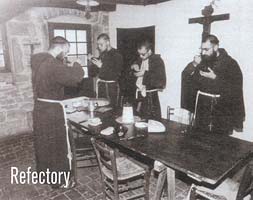 |
 |
Clerics, or Students for the Priesthood
The clerical friar begins as a postulant for two months. Then, as was stated above, he is a novice for a year and wears the habit. During this year, he does manual labor like helping in the kitchen, cleaning and gardening, attends classes and reads books on Franciscan spirituality, the religious life and Christian doctrine.
Then, he makes simple vows for three years and begins philosophy. After three years, he makes his profession of solemn vows for life and begins theology. He is ordained to minor orders during philosophy and to major orders during theology. After three years of theology, he is ordained a priest, but continues studying pastoral theology and sacred eloquence (learning how to preach) for another year. Thus, in all, there are two months as a postulant, a year as a novice, three years of simple vows and philosophy, then the solemn vows and four years of theology, the third year of which he is ordained to the priesthood.
The priests and clerics wear the clerical tonsure or "crown," i.e., the circle of hair; the lay friars wear close-cropped hair completely.
The clerical students also study Church history, the history of the Order, and the Fathers and Doctors of the Church. They also teach Latin, but it is better if one can learn even a little before one enters.
Conditions of Entry
- First of all, of course, the elementary conditions required by Canon Law for all aspirants to the religious life. A high school diploma, at minimum, is required from American aspirants.
- The aspirant must be a friend of peace and concord.
- The aspirant must be at least 16, and no more that 35.
- The aspirant must be a Catholic, faithful to the Church and the Holy Father.
- The aspirant must have good health and sound judgment.
- The aspirant must be well decided to live according to the Gospel, following St. Francis.
The Capuchins advise very strongly anyone who wishes to enter that you should try and learn French before you go. A part-time course, or even better, a full-time course in French makes things easier for both parties. Latin, after all, is helpful, but French is almost indispensable. The Capuchins urge those who need to study French to not worry about time, for time is nothing. Some friars went to college and took full-time courses in French and Latin for the express purpose of entering the friary.
A Final Word
The Capuchin life is not easy. It is hard, but it is not impossible. One of the Popes described their life as "una vita disparata"–a disparate life. "Disparate," however, is not "desperate"! "Disparate" means completely unlike, not the same, utterly different, or even "at odds." When Our Lord first called St. Francis, He said to him by inspiration, "Francis, leave now the worldly and vain pleasures for the things of the spirit; prefer what is bitter to what is sweet; despise yourself if you want to know Me. Once you have changed, you will understand the truth of My words, even if the order of things seems upside-down."
Another time, shortly before his stigmatization (in 1224, two years before his death) by which God set His seal on the Rule, some dissatisfied friars came to him to complain that the Rule was too hard. This Rule was the second that St. Francis had drawn up; the Pope had deemed that his first rule was a bit harsh. (The second rule is the one that we follow today.) When these friars came to complain about the second revised Rule, a voice was heard from heaven, Christ Himself, saying, "Francis, let them understand that it was I who inspired you this rule. If they cannot follow it, let them leave the Order. I know how fragile human nature is: let them know how much I want to help those who embrace this Rule."
In the footsteps of St. Francis, passionate lover of Jesus Crucified, loyally attached to Lady Poverty as to their traditional observances of contemplation and penance, given to the ministry of preaching, the Capuchins work for the restoration of the Reign of our Lord Jesus Christ in joy and peace, simplicity and fraternal charity.
May the most holy Hearts of Jesus and Mary deign to arouse in our youth ardent and self-sacrificing souls, who come to consecrate themselves in service within the modest Capuchin religious family, for more than ever, "the harvest is abundant, but the workers are few."
For information:
Rev. Father Guardian
Convent Saint Francois
Morgon
F-69910 Villie-Morgon
France
